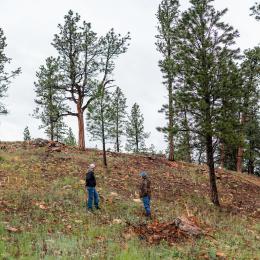After the Fire - Log Erosion Barriers
Log Erosion Barriers (LEBs) are logs placed in a shallow trench on the contour to intercept water running downslope and trap sediment. This treatment may also be known as contour log felling, log terraces, or terracettes.
When are log erosion barriers used?
Log erosion barriers are used on moderate or severely burned slopes ranging between 20 to 60 percent, with erosive soils. LEBs are used where erosion rates have increased significantly because of the fire and there are high values at risk downstream. The site must have enough trees of adequate size to meet treatment objectives (at least 60 trees per acre). Soils can be shallow, but not less than about 8 inches. LEBs increase infiltration, add roughness, reduce erosion, and help retain small amounts of eroded soil on site. LEBs should be effective for a period of one to two years, providing short-term protection on slopes where permanent vegetation will re-establish and provide long-term erosion control.
Materials needed
- 4- to 12-inch diameter logs, 10-30 feet long
- An expert sawyer and labor crew with hand tools
- Machines may be used for moving logs or trenching them in on 30 percent or flatter slopes
How are log erosion barriers installed?
A contour line is marked on the slope to identify the approximate cross slope alignment. Trees along this line are felled on the upstream side of the contour line as much as possible. Stumps are left about 12” high to brace the tree. The logs are cut to a length that permits safe handling and placement for the crew, generally 10 to 30 feet but longer logs can be difficult to manage and therefore, can be broken up into 4-foot segments. Tree limbs are removed to the extent necessary for the log to lie flat on the ground. A shallow trench (about 2 to 6 inches deep) is dug along the contour. The log is placed in the trench and seated with tamped backfill such that water flowing down the slope will not run under it. For this practice to be effective, enough trees must be felled along the contour line to create a semi continuous barrier to the movement of water down the slope, as shown in Figures 1 and 2.
Figure 1 - Theoretical log terracing pattern:

Figure 2 - Typical log and bedding detail:

How many LEBs are required?
Depending on characteristics of the slope, somewhere between 60 and 152 trees per acre are needed for LEBs to be effective. Figure 1 depicts the pattern of LEBs on the slope; recommended spacing for contour slope treatments is as follows.
10 to 20 percent slope steepness:
- 60 feet spacing for moderate burn intensity
- 40 feet spacing for severe burn intensity
20 to 50 percent slope steepness:
- 30 feet spacing for moderate burn intensity
- 20 feet spacing for severe burn intensity
greater than 50 percent slope steepness:
- 15 feet spacing for moderate burn intensity
- 10 feet spacing for severe burn intensity

"CAUTION: After a fire, many trees are weakened from burning around the base of the trunk. These trees can fall over or blow down without warning. Shallow-rooted trees can also fall. Therefore, be extremely alert around burned trees.
Additional Information
Montana Forestry Resources
NRCS Montana guides for forest management and wildfire recovery.
NRCS Forestry Web Page
Forestry and agroforestry information and technical resources that apply to all States.


